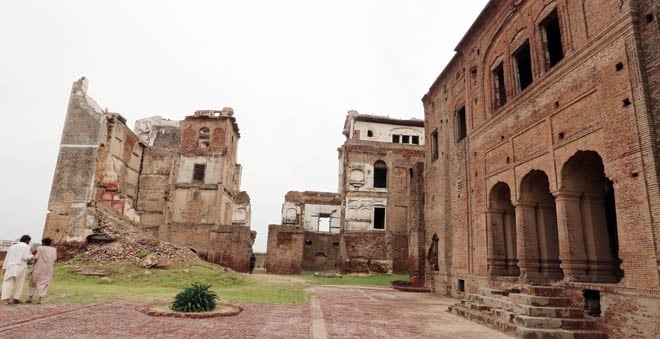

"About 35 kilometres away from Lahore is the city of Sheikhupura. More popularly known as Qila Sheikhupura among the locals, the city was formed and expanded around a fort built by the Mughals in the start of the 17th century.
The Sheikhupura Fort, though small in size compared to some of its more famous counterparts such as the Lahore Fort, was used by different Sikh rulers of Punjab. The rulers added to its original structure within its walls.
In the 19th century, Raja Ranjit Singh presented the fort to his wife and the mother of his heir apparent Kharak Singh. The rani built two havelis inside the fort and, according to some accounts, resided there till her death. Currently, the fort is an amalgamation of Mughal and Sikh cultures.
The fort is in an extremely dilapidated condition. It has been closed to the public for years now. The guard who opens the small door within the huge gate waves us off, fearing we will report what we see in the press. It takes some cajoling on our part for him to let us pass through.
Walking into the fort is like a dream. I get a surreal aura as I cross the gate -- as if the building has a consciousness and is aware of its once grand past. Inside my heart sinks as, at every turn, I see crumbling structures, vandalised walls, and fading frescos. Though there have been media reports since 2010 of a USAID package to restore the fort, and some reports in 2013 suggest the restoration work has started, no sign of this is visible within the fort.
Outside, on one side, a graveyard and other buildings have crawled right up to the wall. The guards there tell us that the authorities have been fighting off land-grabbers who have been trying to take the 200 feet of land around the fort that is marked uninhabitable for heritage sites under the Antiquities Act of 1975. Though they have not been able to protect the fort from all sides, they have been successful in keeping one side clear and have started to build another boundary wall to demarcate protected land.
In contrast, Hiran Minar is relatively better preserved. As we head down the long-winding road, leading to the historical site, we aren’t expecting much after our eye-opening visit of the fort. Towards the end, the minar and the bara darri become visible from a distance.
As we approach it from the parking lot, we feel a sense of calmness in the air. The place apparently has an excellent water gathering mechanism to collect rainwater in the pond surrounding the bara darri. There are people in paddle boats and motor boats in the water that surrounds the bara darri. Unlike the fort, which is a picture of history fading away due to neglect, here it feels like a normal, albeit under-developed, tourist destination.
Since it is situated outside the old city, Hiran Minar and its bara darri has been safe from residential and commercial encroachments. As we walk around the structures, its surrounding grounds, and through a small forest on one side where Jahangir used to hunt, the quiet brings with it a feeling of serenity.
It is only when we approach the bara darri that we see obvious signs of ruins, the unpreserved walls with graffiti on them. It seems wherever we go, every wall is marked with people’s signatures, phone numbers and random slogans. The grounds are strewn with litter, not visible from afar, due to lack of civic sense among visitors and an absence of waste bins in the area.
The minar is closed. Many years ago people used to be able to climb up the spiral staircase within the minar and get a bird eye’s view of the surroundings from the roof. But the structure is no longer stable enough -- some say it is tilting to the side -- and thus has been now closed to visitors.
As we leave Sheikhupura, I think of the tourist potential this city has owing to its heritage. But, like so many other sites, we are losing what we should have preserved out of ignorance, corruption and misplaced priorities."
-- As narrated to Bushra Sultana